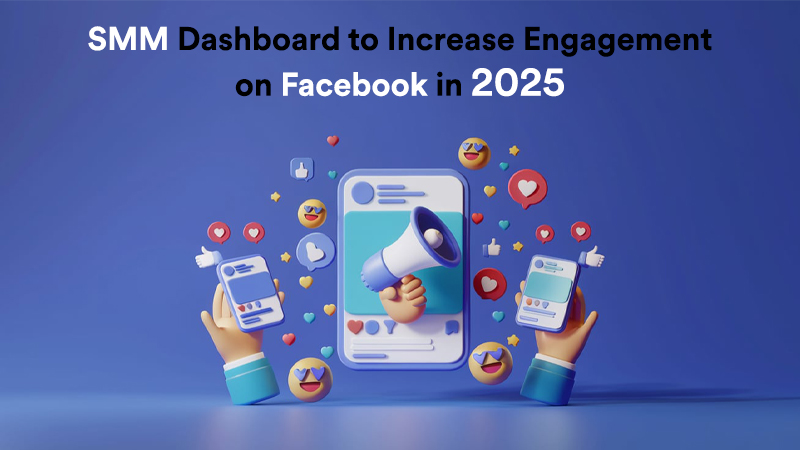
How to Use the SMM Dashboard to Increase Engagement on Facebook in 2025
In 2025, social media marketing (SMM) continues to evolve, and the SMM dashboard has become a vital tool for marketers and businesses aiming to increase engagement on platforms like Facebook. By utilizing the features of an SMM dashboard, you can streamline your social media efforts, track performance, and optimize your content to boost interactions with your audience. Here’s how you can effectively use an SMM dashboard to increase engagement on Facebook in 2025.
1. Analyze Data for Better Insights
One of the main advantages of an SMM dashboard is the ability to analyze data in real time. These dashboards provide valuable insights into how your Facebook content is performing, enabling you to make data-driven decisions.
Track Key Metrics: Metrics such as reach, impressions, clicks, comments, shares, and likes are critical for measuring engagement. The SMM dashboard allows you to monitor these metrics across all your posts to understand which types of content are resonating with your audience.
Review Engagement Reports: Most SMM dashboards offer detailed reports that highlight engagement trends. By examining these reports, you can identify patterns and determine what content generates the highest level of interaction.
Understand Audience Behavior: Knowing when your audience is most active is crucial for posting at the right time. The dashboard provides audience insights, helping you target specific demographics, locations, and behaviors.
2. Optimize and Schedule Content
Consistent posting and high-quality content are key to increasing engagement on Facebook. The SMM dashboard can help you plan and schedule your content in advance, ensuring it reaches the audience at optimal times.
Content Variety: Posting a variety of content types, such as images, videos, polls, and live streams, keeps your audience engaged. The SMM dashboard enables you to schedule these different types of content at strategic times to maintain a consistent presence on Facebook.
Best Times to Post: The SMM dashboard provides analytics on the best times to post for maximum reach and engagement. By scheduling posts during these peak hours, you can ensure that your content is seen by more people and encourages interaction.
A/B Testing: You can test different headlines, post types, or visuals using the A/B testing features of the dashboard. This helps you determine what appeals most to your audience, optimizing your content for better engagement.
3. Engage Actively with Your Audience
Engagement is a two-way street. While publishing content is important, interacting with your followers is equally essential. An SMM dashboard can help you keep track of comments, messages, and interactions in one place.
Monitor Comments and Messages: By staying on top of comments and messages, you can quickly respond to inquiries, feedback, and compliments. Responding in a timely and personable manner can encourage more followers to engage with your content.
Encourage Conversations: Ask questions, run polls, and encourage your audience to share their thoughts and experiences. The SMM dashboard can help you monitor these interactions and track which types of engagement generate the most responses.
Boost User-Generated Content: Encourage your followers to share their content related to your brand. By recognizing and reposting user-generated content, you can build stronger relationships with your community and motivate others to interact.
4. Utilize Paid Advertising for Greater Reach
While organic reach is important, paid advertising is a powerful way to increase visibility and engagement on Facebook. The SMM dashboard helps you manage and track your paid campaigns in one centralized location.
Create Targeted Ads: Use Facebook’s advertising tools within the dashboard to create ads that target specific demographics, interests, and behaviors. Targeting the right audience ensures that your posts are seen by the people most likely to engage.
Track Ad Performance: The SMM dashboard provides detailed reports on the performance of your paid campaigns. Monitoring key metrics such as click-through rates (CTR), conversions, and engagement helps you fine-tune your ads for optimal performance.
Retargeting: Use retargeting features to re-engage users who have interacted with your content before but did not take further action. Retargeting ads can remind users about your brand and encourage them to engage more.
5. Monitor Competitors and Industry Trends
Understanding what your competitors are doing can provide valuable insights into your own Facebook strategy. Many SMM dashboards come with competitor analysis features that allow you to monitor their activity and performance.
Track Competitor Engagement: Use the dashboard to see how your competitors' content is performing in terms of likes, comments, and shares. Identifying their successful strategies can help you refine your own content.
Stay Updated on Trends: The SMM dashboard often aggregates industry trends and topics that are currently popular on Facebook. By staying informed, you can create content that taps into these trends, increasing the chances of higher engagement.
6. Refine Strategies Based on Analytics
Finally, the key to sustained growth in engagement is constant improvement. Regularly reviewing your analytics allows you to adjust your strategies based on performance.
Continuous Learning: The SMM dashboard provides real-time feedback on how your posts are performing, allowing you to adapt quickly and try new approaches. Continuously refine your strategy based on engagement data to maximize results.
Adjust Content Strategy: If you notice certain types of posts are consistently driving more engagement, focus on producing more of that content. Similarly, reduce or alter posts that are underperforming.